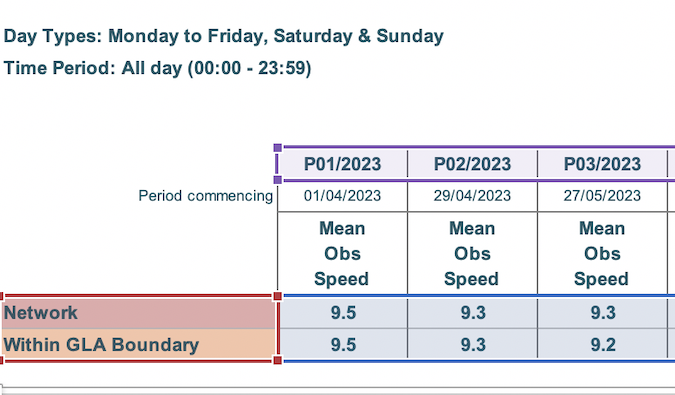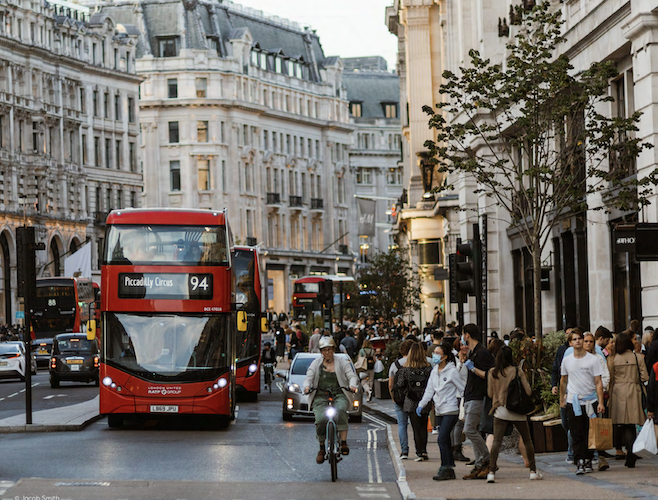It might not seem like very much, but it matters and the direction of travel is not good. The latest Transport for London data about the speed and reliability of the capital’s bus services confirms that they are going backwards at a time when the city badly needs the opposite to be true.
Let’s look at the TfL figures for the average speeds our buses have been going at (they can be found under buses performance data, bus speed reports, network – all day types & all hours – to P03 2023-24).
These show that for the first three monitoring periods of the current financial year, encompassing 1 April until 27 May 2023, the mean (average) speed at which buses travelled within the Greater London Authority boundary throughout a 24-hour day was, respectively, 9.5 miles per hour, 9.3 miles per hour and 9.2 miles per hour.

In all three cases, these were slower than for the equivalent three periods of the last financial year, 2022/23, when the average speeds were 9.7 mph, 9.4 mph and 9.5 mph. And the year before that, 2021/22, they were 9.8 mph, 9.6 mph and 9.5 mph.
The equivalent three years’ worth of figures for just the morning travel peak period – defined as 7am until 10am – aren’t much better, with average speeds between 0.1 and 0.3 mph slower in 2023/24 so far than they were in 2021/22. The highest figure was 9.0 mph for the first monitoring period of 2022/23 and the slowest was 8.3 mph for late April to late May this year.
To this continuing slippage in average speeds since London began emerging from the pandemic – at the peak of which they were often above 10 mph, presumably due to there being less traffic on the roads in general – we can add TfL’s measurement of the average amount of time passengers spend on London buses.
Doing this, in TfL’s words, “enables us to monitor the performance of our bus service from the perspective of our customers”. The shorter the amount of time passengers spend on board, the happier they are likely to be, because it means they’ve completed their journey faster. “Quicker journeys are more likely to encourage people back onto our network as we recover from the pandemic,” is how TfL puts it.
This explanation is included alongside bus journey time figures considered today by TfL’s customer service and operational performance panel. The figures show that the average journey time for the fourth quarter of 2022/23 was 34.5 minutes, missing a target of 33.4 minutes, and that the journey time for 2022/23 as a whole was 34 minutes, missing the annual target of 33.5. That is also the longest average journey time since at least 2018/19, as shown by a TfL chart.

TfL attributes these missed targets to, in the first case, mainly “longer waiting times and lower reliability levels as a result of reduced staff availability at bus operators, mechanical issues and traffic congestion” and, in the second, to “higher lost bus mileage due to staff and mechanical issues” and to “the longer average journey length made by bus customers since the pandemic”.
City Hall published a bus action plan in March 2022, which aspired to providing “fast and reliable journey times” and recognised the bus as “the most commonly used form of public transport in the capital” and “often the unsung hero of London’s transport system”.
Arguments rage about exactly why average bus speeds are falling and journey times are getting longer. On London has asked TfL if it can elaborate further, and this article will be updated when a response is received.
UPDATE, 17 July 2023: In a statement, TfL’s head of bus performance, Philip Gerhardt, acknowledged a “slight decease in average bus speeds compared to 2020/21 and 2012/22” and attributed this to “traffic conditions and the impact of roadworks” returning to pre-pandemic levels. He added:
“The average speed across the network does not reflect the interventions made in specific locations to improve journeys for customers – such as introducing bus lanes and signal re-timings. We remain focused on delivering our Bus Action Plan which commits us to a 10 per cent improvement on speeds recorded in 2015. The introduction of 25km of new bus lanes by 2025 will be central to achieving this target.”
TfL also pointed out that the bus speeds for period three of 2023/24, 9.3 mph, was the same as for the equivalent periods in the pre-pandemic years of 2019/20, 2018/19 and 2017/18.
Twitter: Dave Hill and On London. If you value On London’s output, become a supporter or a paid subscriber to Dave’s Substack.


Wouldn’t be the 20 mph and bike lanes causing the problem?
I see tfl is in denial. The real cause is the policy of 20mph main roads. Congestion joke on third part traffic is still down by at least a 1/3 on pre pandemic levels
Not to worry tho. Give it a few years once driverless cars are used. No need for comuter trains or buses. Or the tube all those self serving greedy drivers out of work.
All that do is winge about third pay .. better than a junior doctors.
IDE say shut tfl completely it’s not working. You can’t travel from se London to sw London the rout you have to take means a 12mile trip by car 1.5hrs
By tfl transport 2.5hrs
We were down 15th June and got the 15 to trafalgar Square and when we got near aldwhich or however you spell it and driver terminated short as bus was running late
This ‘slow down’ could possibly be attributed to the 20mph speed limits being imposed on the majority of roads in London, add to those the LTN’s pushing vehicles onto the roads used by buses, and hey presto traffic slow down. Let’s blame the drivers!!! Idiots
All the evidence points to the fact that expanded cycle lanes, LTNs, and 20mph speed limits are the primary cause of these bus delays, although TfL will vehemently deny it. The evidence is there for all to see. LTNs and widened cycle lanes have squeezed all vehicles unto single-lanes where once, there were two lanes. Moreover, vehicle users cannot escape congestion by using alternative routes because they’ve all been blocked by LTNs. Plus, most buses get caught up in slow-moving 20mph limits so their timetables are screwed by the time get even reach dedicated bus lanes. The whole thing is a complete mess.